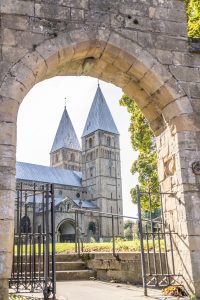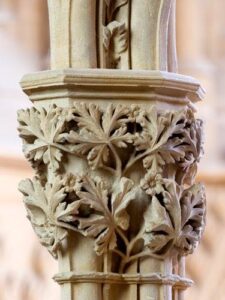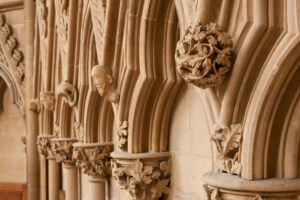Southwell Minster’s remarkable stone carvings: The Leaves of Southwell
 The twin spires of Southwell Minister are home to incredible artefacts from throughout Europe’s history. However some of the Minster’s most iconic features are among its oldest – intricate medieval carvings of plants, animals and mythological Green Men, collectively known as the ‘Leaves of Southwell’. Recently an ambitious conservation mission has been launched, to combat the effects of time, and to ensure these sculptures can be enjoyed by generations to come.
The twin spires of Southwell Minister are home to incredible artefacts from throughout Europe’s history. However some of the Minster’s most iconic features are among its oldest – intricate medieval carvings of plants, animals and mythological Green Men, collectively known as the ‘Leaves of Southwell’. Recently an ambitious conservation mission has been launched, to combat the effects of time, and to ensure these sculptures can be enjoyed by generations to come.
The Leaves were carved over seven centuries ago by medieval masons, who worked their magic on local limestone to sculpt realistic representations of woodland life. Their creations are now regarded as some of the best naturalistic carvings in Europe, notably applauded in Dame Hillary Mantel’s novel Wolf Hall. She describes the forest patterns as “so subtle it is as if… stone had burst into florid life.”
Lining the walls of the Chapter House – a chamber situated just off the north quire aisle – the finely detailed bouquets intertwine and curve smoothly around columns and archways. Together they create the impression that the Chapter House has been enveloped by a forest canopy.
The garlands of ivy, maple, oak, hop, and hawthorn hide all varieties of creatures. It is possible for the eagle-eyed to spy pigs, hares, lions and other animals sheltering beneath the stone greenery, or a dragon winding through the foliage.
Mysterious faces sprouting leaves and vines also appear prominently. These belong to the Green Men – mythological forest figures who feature in architecture throughout Europe. Their origins are steeped in legend, with theories connecting them to pagan symbols of nature and spring, mischievous demons, Robin Hood, and many more. Research is being undertaken to find answers, however the mystery of the Green Men persists.
 Southwell’s leaf motif may be explained by going back in time to the construction of the Chapter House. The end of the thirteenth century was approaching and Southwell would have been encompassed by Sherwood Forest. Many therefore believe that the carvings were intended to reflect the woodland which once thrived beyond the doors of the Minster.
Southwell’s leaf motif may be explained by going back in time to the construction of the Chapter House. The end of the thirteenth century was approaching and Southwell would have been encompassed by Sherwood Forest. Many therefore believe that the carvings were intended to reflect the woodland which once thrived beyond the doors of the Minster.
While these exquisite carvings have stunned visitors from around the world, seven centuries of fluctuating temperature and humidity have put the Leaves in danger of losing their lifelike features. Fortunately, this is where the Leaves of Southwell Project enters the story.
Funding from the National Lottery Heritage Fund has provided the opportunity to enhance the visitor experience of the Chapter House. This has prompted a momentous conservation project aspiring to protect, interpret and better present the foliate carvings.
Repairs are being made to the roof of the chamber, a more suitable micro-climate is being established, and improvements are being made to the accessibility of the site. The project will also attempt a more thorough interpretation of the Leaves, including producing learning materials about the stones and the masons who created them. As a result, more visitors than ever will be able to witness and understand the significance of the carvings.
After seven centuries of being the coldest part of the Minster, underfloor pipes have been laid beneath the Chapter House. This involved the intricate challenge of removing, preserving, and relaying the patchwork of tiles which constitute the chamber floor. The painstaking work reaped unexpected rewards, such as the discovery of historic artefacts – from a Roman coin to a decorated bone peg!

A sculpture in the Chapter House, Southwell Minster, Nottinghamshire damaged by a sword from Cromwellian soldiers billeted in the Minster sometime during the 17th-century Civil War
Finally, state-of-the-art technology has been brought to the Minster to discover more about the enigmatic past of the Leaves. Scientific techniques such as Raman Spectroscopy have been used; this can help reveal whether the carvings were originally painted, and which colours would have decorated them all those years ago.
With the end of the project in sight, the reinvigorated Chapter House is expected to reopen soon. Thanks to the efforts of archaeologists, architects, Minster staff, and many more, we will be able approach the carvings with a greater level of understanding and appreciation. The Leaves of Southwell Project has rejuvenated the sculptures and, in doing so, it is actively keeping the work of the masons, and the spirit of Sherwood Forest, alive. Hopefully it will inspire future generations to explore and unravel the remaining mysteries of the Leaves.
To discover more about the Leaves of Southwell, and to follow the progress of the conservation project, please visit the Southwell Minster website.
Written by Will Parkinson, Economic Growth and Tourism Apprentice.
